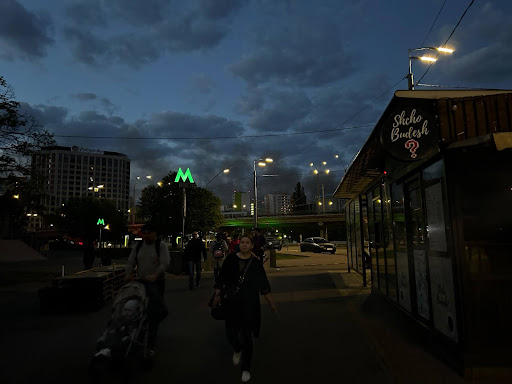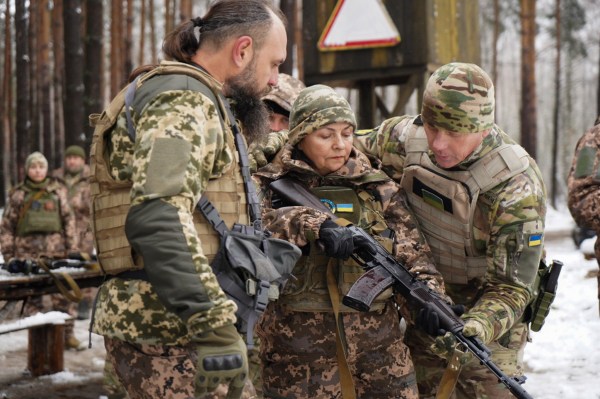KYIV—“We have accepted death,” a friend told me as an air raid siren wailed while we were having wine at one of the few bars that stays open until curfew. The sirens once terrified but now signal exhaustion more than fear. Over the past month, Russia has been pounding Ukrainian cities with drones and missiles, killing dozens, flattening Soviet-era high-rises, burying people under the rubble, and terrorizing civilians.
Moscow says the attacks on the capital—which have been among the worst since the start of the war—are a response to Ukraine's June operation that reportedly took out 30 percent of Russian strategic bombers. And they come even as the Trump administration pushes to broker a negotiated settlement to end the three-and-a-half-year war. However, hardly anyone in Ukraine is convinced Russia is going to stop the war. From taxi drivers to parliamentarians, virtually no one believes Russia would accept any terms short of Ukrainian capitulation. "It's all just bullsh-t," a Ukrainian intelligence officer who spoke on the condition of anonymity told me.
A recent poll by the Kyiv Security Forum and the Razumkov Center
reveals deep distrust among Ukrainians toward any potential peace deal with Russia. Just 28 percent believe an agreement is possible in the near future, while 54 percent say it is not. Even more telling, 66 percent of respondents believe that if a deal were signed, the Russians would break it and attack again as soon as it suited them.
This consensus is something many Ukrainians I talk to feel the West still fails to grasp. Ukrainian officials argue that the American approach to ending the war through a negotiated settlement is based on a fundamental misreading of Moscow’s true intentions. In their view, the only outcome Russia would accept is Ukrainian capitulation, handing Kyiv to the Kremlin without security guarantees. The sooner international partners recognize this, they say, the sooner realistic approaches can emerge.
I met Mykhailo Podolyak, an adviser to Ukrainian President Volodymyr Zelensky, at Adriatik, a neon-lit seafood restaurant near the presidential administration headquarters. The area is blocked off—patrolled by army guards and lined with tank traps. "Russia has one problem that few people understand in the United States and Europe," Podolyak tells me. "Russia cannot get out of the war. They structured the state in such a way that it is cheaper to keep the war than to get out of it. They have no alternative.”
During the latest round of negotiations in Turkey in early June, Russia demanded that Ukraine withdraw its forces from the four regions Moscow claims to have captured—Donetsk, Luhansk, Kherson, and Zaporizhzhia—despite only controlling 70 percent of those areas. The Kremlin also insisted that Ukraine formally recognize the annexation of Crimea, adopt a neutral status barring future NATO membership, and ban all foreign troops from its territory. In addition, Russia pushed for Russian to be reinstated as an official language and the reestablishment of the Moscow Patriarchate of the Russian Orthodox Church in Ukraine. Ukrainian officials describe the demands as purposefully absurd and tantamount to surrender. Talks produced little progress.
"Russia puts forward unfulfillable and unacceptable conditions for Ukraine," said a member of the Ukrainian Parliament who did not want to be named. "All this contradicts the constitution and public consensus. It is obvious that Russia is not waiting for the fulfillment of these conditions, but is using negotiations to delay time. Russia has high hopes for a summer offensive at the front."
Ukrainian officials and much of the public are hoping that President Donald Trump and his administration will recognize Russia's negotiating stance for what it is: a bluff to force concessions it couldn't win on the battlefield. “It is impossible to contain Russia without America,” Podolyak said. “America is the guarantor of Europe's security after WWII. The entire security architecture is built around American presence: American resources, American intelligence, American deterrence. Europe cannot replace that in a month or two.”
Behind closed doors, Kyiv is urging Washington not to reward Moscow's threats with political gains. Ukrainian officials want the U.S. to hold firm, increase pressure, and reassert leadership in the region—making clear that false promises of peace won’t be rewarded.
"We are waiting for President Trump to finally understand that the Russians are fooling him, walking all over him and will take a hawkish position," said a member of parliament representing Ukraine's ruling Servant of the People party.
On the front line, which stretches 746 miles across vast plains dotted by scattered patches of bushes and groves, Moscow is claiming modest success, especially in the hotly contested Sumy and Donetsk regions. The Ukrainian forces are tired and are running short of both men and unmanned aerial vehicles.
A Ukrainian senior lieutenant who had just come back from the front lines explains what those shortages mean for soldiers in the field. “Sometimes, you basically just live on the position,” he said, pointing to the fact that the Ukrainian military has too few resources to rotate forces regularly. “You're under the ground. Your shelter is covered with logs overhead. You might sit there for a month. … Before it was five to 10 days.”
Russia claims to be mobilizing about 50,000 men each month, nearly twice Ukraine’s monthly intake of approximately 27,000. Ukraine has lowered the draft age from 27 to 25, but the U.S. has pressured officials to lower it further. As Ukraine struggles to replenish its forces amid a grinding war of attrition, Russia leverages its larger population and centralized control to sustain its advantage. “If Ukraine had a little more resources for social programs to support military personnel and for military production programs, it would probably be a little easier,” Podolyak said.
Still, Russian forces have failed to complete their takeover of even the Donetsk region, one of their primary stated objectives, despite their overwhelming numerical and material advantages. “The field between our and their positions is soaked in blood,” a Ukrainian soldier on the front told me.
Month after month, Russian units expend enormous resources fighting for individual towns and villages, often sustaining massive casualties for minimal territorial gains. Multiple sources, including the U.K. Defense Ministry and the U.S.-based Center for Strategic and International Studies have projected that Russian casualties have reached or topped the 1 million mark.
This suggests Russian capabilities may be more limited than rhetoric suggests. “With such a dynamic, it will take five more years for them to finish the occupation of Donetsk region,” said Serhiy Leshchenko, an adviser to Zelensky.
Russia's relentless bombardment carries a strategic message beyond the immediate destruction: Moscow is trying to signal that it can sustain the war indefinitely, hoping to use fatigue and exhaustion among Ukrainians and Western decision makers to its advantage.
“The idea that Russia can wage this war forever is a myth. They can't. They're surviving on propaganda and fear,” Podolyak said. “They're using North Korean missiles—KN-23. They've run out of ammunition. The only thing they have left is people. They've emptied their prisons. They can send more bodies. That's it. Everything else, they're stretched thin."
On the battlefield, the nature of the war is changing, too. Drones now define the front, conducting surveillance as well as offensive operations. But even this drone battle is shifting, as each side adapts and counters the other by deploying new tactics and technologies in an unending cycle of escalation.
Russia now uses fiber optic drones connected by long wires (up to 20 kilometers) that can't be jammed. "A year ago, FPV (first-person view) with wire cable was something exotic. Now FPV with wire is a daily routine," Leshchenko said about the new types of threats on the front lines. "The reality of war changes every six months. Maybe next is FPV with artificial intelligence, and it will change the logic of war again."
These drones are slower and less flexible, but they're much harder to stop. They are physically connected to the operator and still work even when other drones lose signal. Drones now are main weapons for the both sides. "If before it used to be artillery, now up to 80 percent of destroyed targets are by drones. We use drones to destroy their personnel and equipment," said the Ukrainian senior lieutenant. "We must make it so that any Russian who enters the space between our positions and theirs knows he is guaranteed to die."
The Iranian-designed Shahed-type drones targeting Kyiv have also evolved to fly higher and faster. It’s increasingly difficult for mobile air defense units to track and shoot them down.
The strain is not limited to the battlefield, but is felt across Ukrainian society. Recent polling by the Kyiv International Institute of Sociology reveals evolving public attitudes toward territorial concessions. Nearly one-third of Ukrainians now express willingness to cede some territory for peace. This is a considerable increase from the 10 percent who held such views in May 2022, with the absolute majority, 82 percent, opposing any concessions. Today, 55 percent still oppose any territorial concessions, but the polling suggests that Ukrainian society, like its leadership, is grappling with the costs of continued war.
“Could you carry this war for another 10 years if need be?” I asked a Ukrainian official close to the presidential administration. He looked out the window pointing at young men passing by. “Look,” he said. “We can. What other option do we have anyway?”
But exhaustion is taking its toll on Ukrainians. As American engagement draws down, hopes for a strategically sound resolution are fading. “People hoped for a solution and agreement to be reached. Leadership by now understands it’s very unlikely. But soon the population will also fully grasp it and depression will set in,” said the official.
Like a broken record, Ukrainian officials argue the stakes extend far beyond their borders. In their view, what appears to be a regional conflict over territory is a test of whether the West can still enforce the rules-based system it created or authoritarian powers will be emboldened to challenge it elsewhere. “It's important to prevent the escalation which will not only lead to the third world war but destroy the global order which made America successful," Leshchenko said.
Kyiv has made clear what it considers an acceptable endgame: concrete security guarantees robust enough to deter future Russian aggression. Yet Western capitals show little appetite for this kind of long-term commitment. “You either lose or you force Russia to peace. That's it. Those are the only two outcomes. You can do it today, or in five years,” Podolyak said, speaking about Western response. “The West is still afraid to make decisions without paying attention to Russia's position.”
While Washington explores pathways to end the war, Moscow is escalating it. The Russian forces are pressing the frontlines as part of a new summer offensive. The push will likely be around the Sumy region, along the Russian border. Russian troops have already captured a few villages in the area but the progress so far has been limited. Russia briefly occupied Sumy at the start of the full-scale invasion in 2022 but was driven out later that year by Ukrainian counterattacks.
"Summer is always the season for ground operations: dry soil, long days, short nights, warm weather, and green cover," said Leshchenko. "If Russians manage to take Sumy, it would be the first regional capital they've seized in three years."
Recent moves by the Trump administration are more encouraging for weary Ukrainians: After the Defense Department announced a halt in military assistance, President Trump ordered the Pentagon to reverse the decision and has discussed sending Patriot missiles to Ukraine. But for now, the Russian attacks on civilian areas are only increasing.
“Russia comes to kill,” a Ukrainian official said. “And whether you want to defend the country or not, you have to. There is no other way out. No other way out.”






Please note that we at The Dispatch hold ourselves, our work, and our commenters to a higher standard than other places on the internet. We welcome comments that foster genuine debate or discussion—including comments critical of us or our work—but responses that include ad hominem attacks on fellow Dispatch members or are intended to stoke fear and anger may be moderated.
With your membership, you only have the ability to comment on The Morning Dispatch articles. Consider upgrading to join the conversation everywhere.